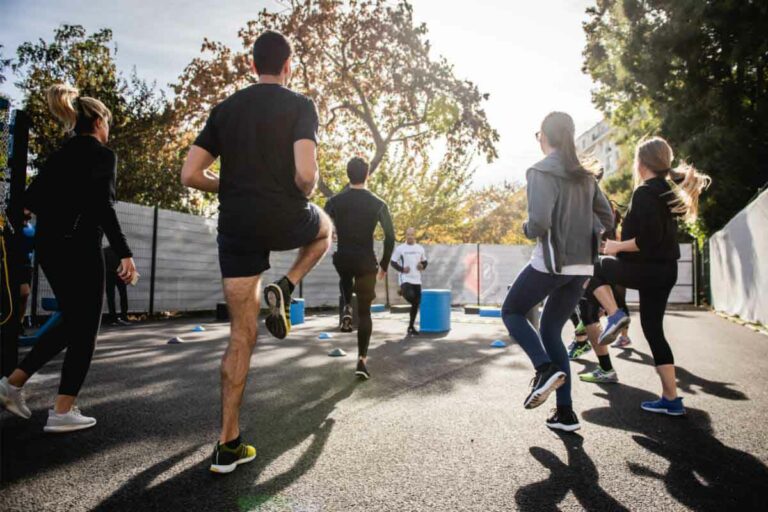Does Running Give You Abs? (Get Fit: The Link Between Running and Abs)

If you’re looking to get a six-pack from running, the good news is that it’s absolutely possible.
So, does running give you Abs? Like any fitness goal, the results won’t come overnight—it will take hard work and dedication to achieve your goals.
- While running can help strengthen your core and burn fat, it is not enough to give you abs on its own.
- To achieve visible abs, you must focus on proper nutrition and incorporate targeted ab exercises into your fitness routine.
Here are some tips for getting a six-pack with running.
Create A Running Routine That Challenges You
If you want to see results with running, then you must push yourself and challenge your body.
Every week, find ways to increase what you do; whether it be speed or duration, continually growing will help you to break through plateaus and build muscle faster.
Benefits Of A Challenging Running Routine
Running is one of the best workouts if you want to challenge yourself and increase endurance and stamina.
You should learn to continue pushing forward, regardless of how long it takes or how much energy it requires.
As your stamina and endurance increases, so will your ability to push yourself farther during a single session – which in turn positively impacts your overall aerobic fitness level.
As we all know, our heart is the most important organ in our body, which makes it all the more important to ensure that it remains healthy.
Engaging in a tough running routine can lead to improved cardiovascular health, as the increased activity helps strengthen and enlarge the heart muscle; this allows for increased efficiency when it comes to delivering oxygenated blood throughout your body.
This in turn can have a positive effect on building great abs.
Take Rest Days
It’s crucial not to neglect rest days so that you can give your body ample time to recuperate and repair tissues broken down during exercise routines—this process is actually what stimulates muscle development!
A born rule is to limit abdominal workouts no more than three times per week, while paying careful attention to ensure ample rest time between workouts.
Target Your Abdominal Muscles
Part of your running routine should include exercises specifically targeting your abdominal muscles.
Do both traditional sit-ups and crunches, as well as additional core exercises such as mountaineers or planks between runs.
Having great abs doesn’t mean just having an aesthetic look – having extra core strength will help make your runs more efficient and enjoyable!
If you’re just starting out, it’s best practice to focus on completing 8–15 reps for two sets of each exercise before increasing reps over time as you build endurance and strength in both your upper and lower abdominal muscles over multiple sessions dedicated specifically to working those areas.

Make Sure You Eat Right
In order to wipe off that layer of fat over your abdominal muscles, nutrition is key. Make sure you are eating wholesome foods that fuel your body without loading on empty calories.
Also consider supplementing protein into your diet with shakes or bars in order to maximize muscle growth potential, since proteins are required for proper recovery after any workout session.
Protein helps repair and build muscle, so including it in your diet plan is essential if you want to have a shredded core.
Foods that are high in protein include lean meats, fish, eggs, nuts, seeds, legumes, and dairy products like Greek yogurt. Try to aim for around 15-30g of protein per meal.
Fresh fruits like apples, pears, and oranges are filled with vitamins and minerals that support overall health; whereas plenty of vegetables each day will help provide the dietary fiber needed for digestive health.
To make sure your meals are nutritious, to try adding cooked vegetables into breakfast dishes like scramble tofu or omelets; enjoy raw leafy greens with lunch salads; or roast root vegetables with dinner mains.
Before Your Run
Complex carbohydrates will provide lasting energy, keeping blood sugar levels constant throughout your run.
Try eating oats and quinoa, brown rice, sweet potatoes, and whole-wheat bread. Complex carb sources are also high in fiber, which will help stabilize your blood sugar levels and keep you feeling energized for a longer time.
Adding a few servings of fruits and vegetables will give you essential micronutrients that can help aid muscle repair.
Fruits like oranges or bananas are great pre-run snacks because they contain natural sugars for energy as well as potassium for muscle health.
Finally, if you’re looking for an extra boost of energy before running, then it might be helpful to consume some caffeine like coffee or tea.
Caffeine can give an instant surge of energy, whereas carbs require some digestion first before its effects are felt by the body.
However, make sure not to have any more than about 200-400 mg in order to avoid potential side effects like cramping/nausea.
Focus On Proper Hydration Habits
Maintaining adequate hydration levels throughout the day can really enhance the benefits of any workout routine, both physically and mentally.
Proper hydration can also lead to additional energy, better functioning muscles and improved joint health over time due primarily to water’s role in flushing out toxins from the body naturally when drunk in abundance each day.
Stay Consistent With Your Progressions
Lastly, just ensure that throughout all of this stay consistent in all of your progressions, no matter how small they may seem at first glance every small upgrade helps improve overall performance every single mile!
Having fitness goals can help motivate you and help achieve your fitness goals.
Remember, motivation, action, and purpose are all different but work in harmony. If you take action, the motivation will come to carry on.
Similarly, if you are in touch with the purpose, that will give you motivation to take action.
Final Thoughts
Running can be an effective way to get a six-pack. It requires dedication and consistency to achieve the desired results.
Eating a balanced diet that includes complex carbohydrates, fruits and vegetables, and staying hydrated are all important factors for success.
Additionally, setting goals and staying motivated will help you stay on track with your progressions. With these guidelines followed consistently, it is possible.






